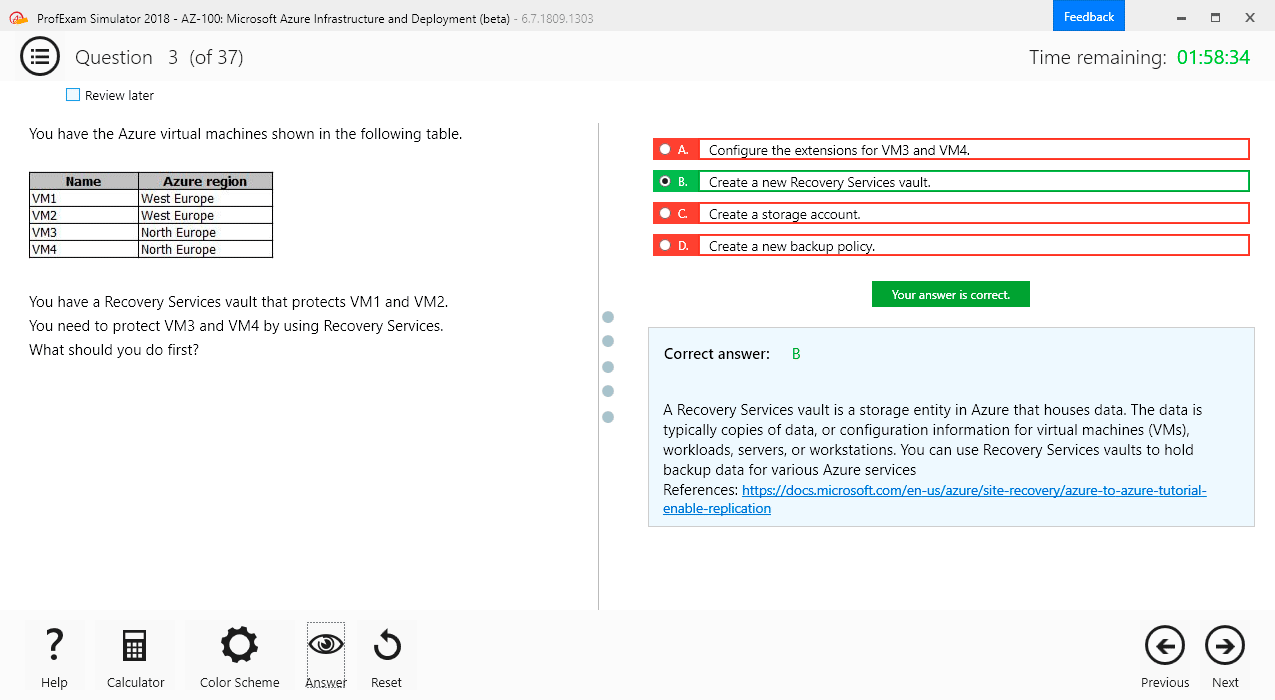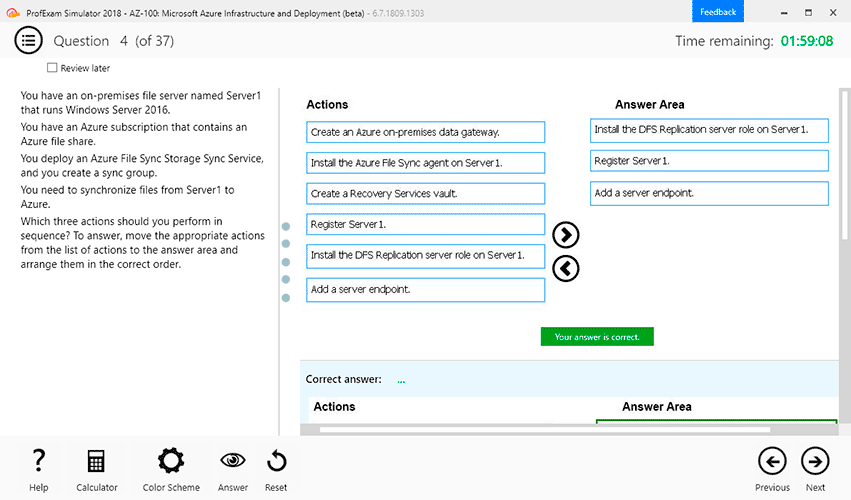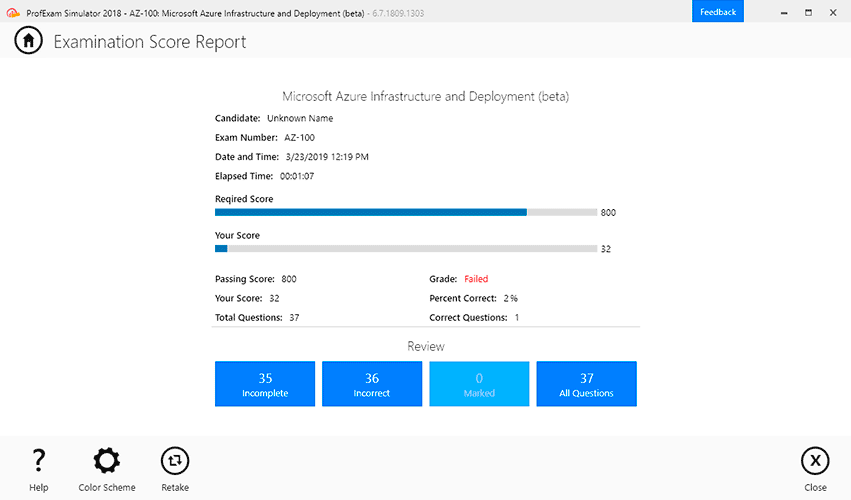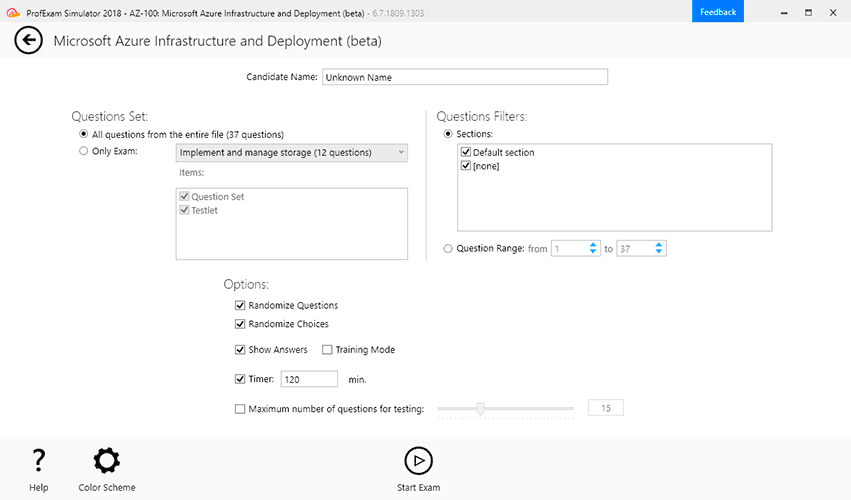File Info
| Exam | EC-Council Certified Security Specialist Practice Test |
| Number | ECSS |
| File Name | ECCouncil.ECSS.VCEplus.2024-11-02.38q.vcex |
| Size | 43 KB |
| Posted | Nov 02, 2024 |
| Download | ECCouncil.ECSS.VCEplus.2024-11-02.38q.vcex |
How to open VCEX & EXAM Files?
Files with VCEX & EXAM extensions can be opened by ProfExam Simulator.
Coupon: MASTEREXAM
With discount: 20%





Demo Questions
Question 1
Bob has secretly installed smart CCTV devices (loT devices) outside his home and wants to access the recorded data from a remote location. These smart CCTV devices send sensed data to an intermediate device that carries out pre-processing of data online before transmitting it to the cloud for storage and analysis. The analyzed data is then sent to Bob for initiating actions.
Identify the component of loT architecture that collects data from loT devices and performs data preprocessing.
- Data lakes
- Streaming data processor
- Gateway
- A Machine learning
Correct answer: C
Explanation:
In the context of IoT architecture, the component that collects data from IoT devices and performs data preprocessing is typically referred to as aGateway. This device acts as an intermediary between the IoT devices and the cloud infrastructure. It is responsible for aggregating data, performing initial processing, and then transmitting the data to the cloud for further storage and analysis. Gateways are crucial for reducing latency, providing local data buffering, and ensuring that only necessary data is sent to the cloud, thereby optimizing network and storage resources. In the context of IoT architecture, the component that collects data from IoT devices and performs data preprocessing is typically referred to as aGateway. This device acts as an intermediary between the IoT devices and the cloud infrastructure. It is responsible for aggregating data, performing initial processing, and then transmitting the data to the cloud for further storage and analysis. Gateways are crucial for reducing latency, providing local data buffering, and ensuring that only necessary data is sent to the cloud, thereby optimizing network and storage resources.
Question 2
Which of the following MAC forensic data components saves file information and related events using a token with a binary structure?
- Kexts
- User account
- Command-line inputs
- Basic Security Module
Correct answer: D
Explanation:
In the context of MAC (Mandatory Access Control) forensics, the Basic Security Module (BSM) is known to save file information and related events using a token with a binary structure. BSM is part of the auditing system that records security-related events and data. Each BSM audit record is composed of one or more tokens, where each token has a specific type identifier followed by data relevant to that token type. This structure allows for a detailed and organized way to store and retrieve event data, which is crucial for forensic analysis. In the context of MAC (Mandatory Access Control) forensics, the Basic Security Module (BSM) is known to save file information and related events using a token with a binary structure. BSM is part of the auditing system that records security-related events and data. Each BSM audit record is composed of one or more tokens, where each token has a specific type identifier followed by data relevant to that token type. This structure allows for a detailed and organized way to store and retrieve event data, which is crucial for forensic analysis.
Question 3
Roxanne is a professional hacker hired by an agency to disrupt the business services of their rival company. Roxanne employed a special type of malware that consumes a server's memory and network bandwidth when triggered. Consequently, the target server is overloaded and stops responding.
Identify the type of malware Roxanne has used in the above scenario.
- Rootkit
- Armored virus
- worm
- Spyware
Correct answer: C
Explanation:
In the scenario described, the malware that consumes a server's memory and network bandwidth, causing the server to overload and stop responding, is typically aworm. Worms are a type of malware that replicate themselves and spread to other computers across a network, often consuming significant system resources and network bandwidth in the process. Unlike viruses, which require human action to spread, worms typically exploit vulnerabilities or use automated methods to propagate without the need for user intervention. In the scenario described, the malware that consumes a server's memory and network bandwidth, causing the server to overload and stop responding, is typically aworm. Worms are a type of malware that replicate themselves and spread to other computers across a network, often consuming significant system resources and network bandwidth in the process. Unlike viruses, which require human action to spread, worms typically exploit vulnerabilities or use automated methods to propagate without the need for user intervention.
Question 4
James is a professional hacker attempting to gain access to an industrial system through a remote control device. In this process, he used a specially designed radio transceiver device to sniff radio commands and inject arbitrary code into the firmware of the remote controllers to maintain persistence.
Which of the following attacks is performed by James in the above scenario?
- Malicious reprogramming attack
- Re pairing with a malicious RF controller
- Command injection
- Abusing reprogramming attack
Correct answer: A
Explanation:
James is performing amalicious reprogramming attackin the given scenario. He uses a specially designed radio transceiver device to sniff radio commands and inject arbitrary code into the firmware of the remote controllers.This allows him to maintain persistence and potentially gain unauthorized access to the industrial system.EC-Council Certified Security Specialist (E|CSS) documents and study guide12. James is performing amalicious reprogramming attackin the given scenario. He uses a specially designed radio transceiver device to sniff radio commands and inject arbitrary code into the firmware of the remote controllers.
This allows him to maintain persistence and potentially gain unauthorized access to the industrial system.
EC-Council Certified Security Specialist (E|CSS) documents and study guide12.
Question 5
While investigating a web attack on a Windows-based server, Jessy executed the following command on her system:
C:\> net view <10.10.10.11>
What was Jessy's objective in running the above command?
- Verify the users using open sessions
- Check file space usage to look for a sudden decrease in free space
- Check whether sessions have been opened with other systems
- Review file shares to ensure their purpose
Correct answer: D
Explanation:
Thenet viewcommand in Windows is used to display a list of resources being shared on a computer.When used with a specific computer name or IP address, as innet view <10.10.10.11>, it displays the shared resources available on that particular computer1. Jessy's objective in running this command was likely to review the file shares on the server with the IP address 10.10.10.11 to ensure that they are correctly purposed and not maliciously altered or added as part of the web attack.This command does not verify users using open sessions, check file space usage, or check whether sessions have been opened with other systems. Instead, it specifically lists the shared resources, which can include file shares and printer shares, providing insight into what is being shared from the server in question. This information is crucial during a forensic investigation of a web attack to understand if and how the server's shared resources were compromised or utilized by the attacker. Thenet viewcommand in Windows is used to display a list of resources being shared on a computer.When used with a specific computer name or IP address, as innet view <10.10.10.11>, it displays the shared resources available on that particular computer1. Jessy's objective in running this command was likely to review the file shares on the server with the IP address 10.10.10.11 to ensure that they are correctly purposed and not maliciously altered or added as part of the web attack.
This command does not verify users using open sessions, check file space usage, or check whether sessions have been opened with other systems. Instead, it specifically lists the shared resources, which can include file shares and printer shares, providing insight into what is being shared from the server in question. This information is crucial during a forensic investigation of a web attack to understand if and how the server's shared resources were compromised or utilized by the attacker.
Question 6
Identify the backup mechanism that is performed within the organization using external devices such as hard disks and requires human interaction to perform the backup operations, thus, making it suspect able to theft or natural disasters.
- Offsite data backup
- Cloud data backup
- Online data backup
- Onsite data backup
Correct answer: D
Explanation:
The backup mechanism described in the scenario, which involves using external devices (such as hard disks) and requires human interaction for backup operations, is known asonsite data backup. In this approach, backups are stored within the organization's premises, making them susceptible to theft, damage, or natural disasters. It is essential to consider additional offsite or cloud-based backup solutions to enhance data resilience and security. The backup mechanism described in the scenario, which involves using external devices (such as hard disks) and requires human interaction for backup operations, is known asonsite data backup. In this approach, backups are stored within the organization's premises, making them susceptible to theft, damage, or natural disasters. It is essential to consider additional offsite or cloud-based backup solutions to enhance data resilience and security.
Question 7
Michael, a forensic expert, was assigned to investigate an incident that involved unauthorized intrusion attempts. In this process, Michael identified all the open ports on a system and disabled them because these open ports can allow attackers to install malicious services and compromise the security of the system or network.
Which of the following commands assisted Michael in identifying open ports in the above scenario?
- nmap -sT localhost
- netstat -i
- ilconfig promise
- netstat rn
Correct answer: B
Explanation:
Michael used thenetstatcommand with the-ioption to identify open ports on the system. The-iflag displays network interfaces and their statistics, including information about open ports. By analyzing this output, Michael could determine which ports were active and potentially vulnerable to unauthorized access.EC-Council Certified Security Specialist (E|CSS) course materials and study guide12.EC-Council Certified Security Specialist (ECSS) program information1.EC-Council ECSS Certification Syllabus and Prep Guide.EC-Council ECSS Certification Sample Questions and Practice Exam.EC-Council ECSS brochure3. Michael used thenetstatcommand with the-ioption to identify open ports on the system. The-iflag displays network interfaces and their statistics, including information about open ports. By analyzing this output, Michael could determine which ports were active and potentially vulnerable to unauthorized access.
EC-Council Certified Security Specialist (E|CSS) course materials and study guide12.
EC-Council Certified Security Specialist (ECSS) program information1.
EC-Council ECSS Certification Syllabus and Prep Guide.
EC-Council ECSS Certification Sample Questions and Practice Exam.
EC-Council ECSS brochure3.
Question 8
Alana, an employee in an organization, took a short break after spending exhausting hours on a project. For relaxation, she went to a cafeteria with her laptop, where she connected to the public Internet. While browsing the web, she received a project modifications file on her mail and reverted with another file that contained the required changes.
Which of the following BYOD risks has emerged from the above scenario?
- Mixing personal and private data
- Endpoint security issue
- Improper disposing of devices
- Sharing confidential data on unsecured networks
Correct answer: D
Explanation:
In the given scenario, Alana's actions pose a risk related tosharing confidential data on unsecured networks. Here's why:BYOD (Bring Your Own Device): Alana used her personal laptop in a public cafeteria. This falls under the BYOD concept, where employees use their personal devices for work-related tasks.Unsecured Network: Connecting to the public Internet in a cafeteria means she is using an unsecured network. Public Wi-Fi networks are often vulnerable to eavesdropping and unauthorized access.Email Communication: Alana received a project modifications file via email and sent back another file with changes. Email communication over an unsecured network can expose sensitive information to potential attackers.Risk: By sharing project-related files over an unsecured network, Alana risks exposing confidential data to unauthorized individuals.EC-Council Certified Security Specialist (E|CSS) course materials and study guide.EC-Council Certified Security Specialist (E|CSS) documents and course content12. In the given scenario, Alana's actions pose a risk related tosharing confidential data on unsecured networks. Here's why:
BYOD (Bring Your Own Device): Alana used her personal laptop in a public cafeteria. This falls under the BYOD concept, where employees use their personal devices for work-related tasks.
Unsecured Network: Connecting to the public Internet in a cafeteria means she is using an unsecured network. Public Wi-Fi networks are often vulnerable to eavesdropping and unauthorized access.
Email Communication: Alana received a project modifications file via email and sent back another file with changes. Email communication over an unsecured network can expose sensitive information to potential attackers.
Risk: By sharing project-related files over an unsecured network, Alana risks exposing confidential data to unauthorized individuals.
EC-Council Certified Security Specialist (E|CSS) course materials and study guide.
EC-Council Certified Security Specialist (E|CSS) documents and course content12.
Question 9
Bob, a security professional, was recruited by an organization to ensure that application services are being delivered as expected without any delay. To achieve this. Bob decided to maintain different backup servers for the same resources so that if one backup system fails, another will serve the purpose.
Identify the IA principle employed by Bob in the above scenario.
- Integrity
- Confidentiality
- Authentication
- Availability
Correct answer: D
Explanation:
In the given scenario, Bob's decision to maintain different backup servers for the same resources demonstrates the principle ofavailability. By having redundant backup systems, Bob ensures that the services remain accessible even if one system fails. In the given scenario, Bob's decision to maintain different backup servers for the same resources demonstrates the principle ofavailability. By having redundant backup systems, Bob ensures that the services remain accessible even if one system fails.
Question 10
Peter, a network defender, was instructed to protect the corporate network from unauthorized access. To achieve this, he employed a security solution for wireless communication that uses dragonfly key exchange for authentication, which is the strongest encryption algorithm that protects the network from dictionary and key recovery attacks.
Identify the wireless encryption technology implemented in the security solution selected by Peter in the above scenario.
- WPA
- WPA3
- WEP
- EAP
Correct answer: B
Explanation:
Peter's security solution for wireless communication uses thedragonfly key exchangefor authentication. This key exchange method is a crucial component ofWPA3(Wi-Fi Protected Access 3). WPA3 is an improved wireless security protocol that enhances protection against dictionary attacks and provides forward secrecy. The dragonfly handshake in WPA3 makes it impossible for attackers to record the 4-Way Handshake and launch offline dictionary attacks.Additionally, WPA3 introduces perfect forward secrecy, preventing attackers from decrypting past traffic after a key breach12.EC-Council Certified Security Specialist (E|CSS) documents and study guideEC-Council Certified Security Specialist (E|CSS) course materials3 Peter's security solution for wireless communication uses thedragonfly key exchangefor authentication. This key exchange method is a crucial component ofWPA3(Wi-Fi Protected Access 3). WPA3 is an improved wireless security protocol that enhances protection against dictionary attacks and provides forward secrecy. The dragonfly handshake in WPA3 makes it impossible for attackers to record the 4-Way Handshake and launch offline dictionary attacks.Additionally, WPA3 introduces perfect forward secrecy, preventing attackers from decrypting past traffic after a key breach12.
EC-Council Certified Security Specialist (E|CSS) documents and study guide
EC-Council Certified Security Specialist (E|CSS) course materials3

